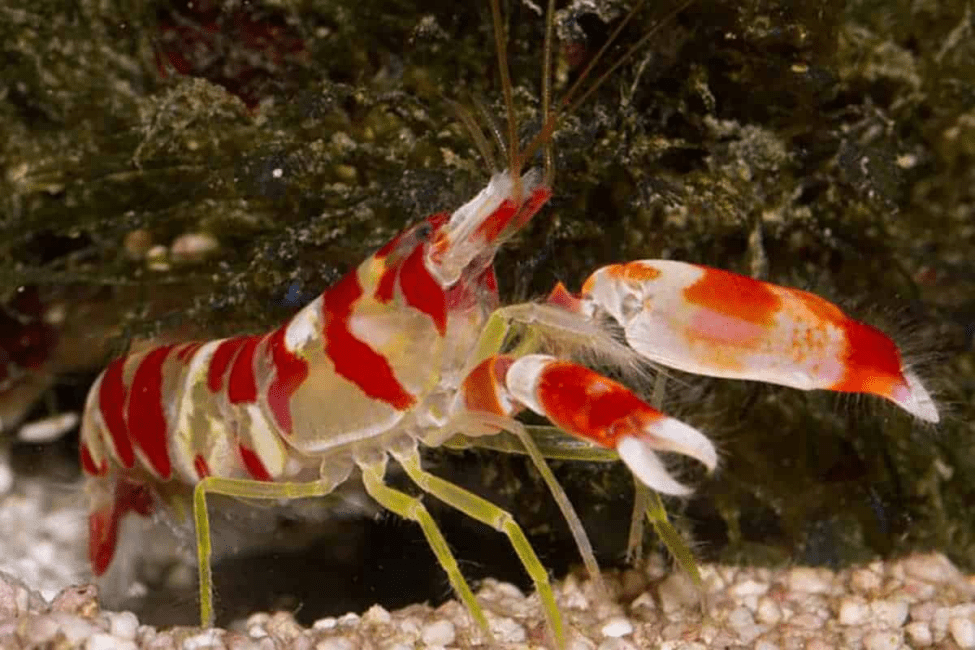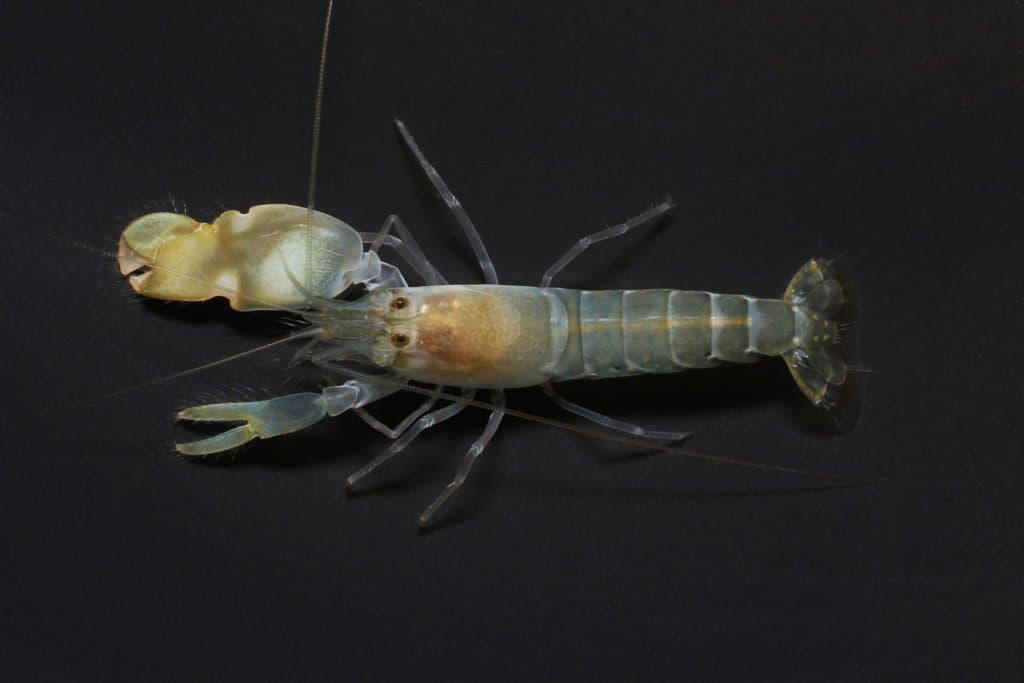Pistol shrimp are blind and mostly inhabit oyster reefs, coral reefs, and seagrass belonging to the family Alpheidae. They are mostly found in both seawater and freshwater bodies. They are called pistol shrimps because the sound they produce with their claws is usually louder than that of a gunshot as the sound measures about 218 decibels.
Alphadae is characterized by having asymmetrical claws and are usually capable of making a loud snapping sound and they belong to the family of caridean snapping shrimps.
Other related names of animals in this group are known as pistol shrimp or Alpheid shrimp. Pistol shrimps usually grow to a size of about 4 – 5 centimeters or 1 – 3 inches.
Pistol shrimp, also known as snapping shrimp, are a crustacean in the family Alpheidae. Their two front claws are different sizes, with one being notably larger than the other.
There are hundreds of species found all over the world, but most species are found in reefs and seagrass beds in temperate and tropical regions. They’re not very big, only reaching a few inches in size, but their large claws can grow to half its body length.
This large claw holds the pistol shrimp’s superpower. When a pistol shrimp senses prey is nearby, it will open the top part of its big claw, allowing some water to enter a small chamber in the crook of the claw. Then, when it clamps down, the pressure from a small plunger on the top claw forces the water out of the chamber.
This happens so fast that it creates bubbles. And not just any bubbles: these bubbles can speed out at 60 miles per hour, fast enough to stun or kill the prey! When the bubbles pop, it makes a snap sound that gives these shrimp their name.
The bubbles are loud. Like, really loud. The snap of one recently-discovered species of pistol shrimp called Synalpheus pinkfloydi named after something else that is also loud and very cool: Pink Floyd and can reach 210 decibels.
That is louder than an actual gunshot, which is around 140 – 175 decibels. You can hear them for yourself by sticking your head below the water on a reef and listening for the snap snap snap.
The pistol shrimp’s mighty snap comes in handy for more than just lunch. Its powerful claw can deter predators or other competitors looking to take over the shrimp’s burrow. It also makes males more attractive to the ladies – larger claws suggest they are better mates.
Read Also: How to Extract and Package Snail Slime (Snail filtrate) for Commercial Use
How Pistol Shrimps Reproduce

Shrimps are monogamous for a heeding season. The mating process of the pistol shrimps starts with snapping, the female pistol shrimps usually molt first and they mate later.
Then every few weeks, the female molts while the male protects or guides her to keep her safe. The eggs are then incubated under the female’s abdomen. The larvae molt and transform into shrimp.
Pistol shrimps live for about 3 to 4 years in open range while in captivity, they live for 2 to 4 years as proven by researchers. However, It is not advisable to keep them in an aquarium because they are capable of breaking glasses. Predators of pistol shrimp include groupers, lionfish, triggers, hawkfish, etc.
Pistol shrimp can’t kill humans by just snapping its claw but it can kill a human if the human is allergic to shrimp, consumes one, and then suffers from anaphylaxis shock.
Pistol Shrimp Snapping Techniques
Shrimps produce a loud snapping sound by a rapid closure of the claw and its snapping sound is known to be one of the loudest snapping sounds in the oceans.
Normally, the shrimps use its claw as an instrument for communication and weapon. Therefore, the pistol shrimps are renowned for their powerful snapping technique.
Read Also: Snail Farming Step-by-Step Beginners Guide
Habitat of Pistol Shrimp
Pistol shrimp are commonly or usually found in coral reefs, oyster reefs, and muddy estuaries.
Most pistol shrimps live or dwell in tropical temperate coastal and marine water.
Caring and Keeping Pistol Shrimps
It is relatively easy to take care of pistol shrimp, you can start by making sure that the invert has plenty of room to explore as the shrimps spend much of their time in its lair.
Always make sure you feed your shrimp regularly, provide them with mineral and iodine supplements to keep them healthy to enable their mooting process.
Feeding Methods of Pistol Shrimps
Pistol shrimps are detritus feeders and apart from feeding on detritus they also feed on small meaty foods such as brine shrimp, scallop, mussels, and Mysis shrimp.
Some Interesting Facts About The Pistol Shrimps
They are the loudest sea/ocean creature and when they are together in a group or colony, they tend to interfere with underwater communication and sonar.
They are very small in size and usually don’t grow more than 3 to 5cm in length, they are the major sources of noise in the ocean.
Read Also: Feeding Levels for Catfish at a Water Temperature of 27-28°C
Pistol Shrimp Appearance
The pistol shrimp (also known as the snapping shrimp) is a family of shrimp species that is found mostly in tropical waters and has a distinctive over-sized claw.
The more than 500 species of pistol shrimp all differ slightly in appearance and location but share the large boxing-glove claw with the other one being slightly smaller in size.
These tiny creatures aren’t harmful to humans, nor can we be affected by their claw. However, pistol shrimp have the ability to create incredible heat and sound that would damage their predator’s. These small yet powerful shrimp are about two inches long and can be heard over a quiet boat if you listen closely.
Although it may seem that pistol shrimps have evolved these to have a stronger claw for both hunting and fighting, it is actually designed for these things but works in a very special way. By snapping the claw shut, pistol shrimps are able to stun their prey before they are then safe to kill and consume it.
How Pistol Shrimp Claws Work

Pistol shrimp claws snap together with such force that they produce a stream of water that travels as a pressure bubble at speeds of roughly 71 mph (105 feet per second) towards its prey. Once popped though, the deafening crack of these bubbles reaches up to 218 decibels. It also:
- Emits light for a billionth of a second.
- For a fraction of a second, temperatures in the bubble soar to nearly 4,800 degrees Celsius (which is a remarkable outcome from a two-centimeter long animal shutting its claw!)
- And also stuns small fish and crabs instantly.
Now, the first question you’re probably asking yourself is how can a tiny creature produce temperatures nearly as hot as the sun’s surface and noise louder than a pistol firing?
The answer comes from the unique structure of the pistol shrimp’s snapping claw. When pistol shrimp open their claw, water fills into a socket. The other half of the claw is a plunger that rapidly closes and ejects water that escapes through small grooves at extremely high velocity.
What happens next is a phenomenon known as a cavitation bubble. Pressure drops dramatically which vaporizes local water. Tiny bubbles grow large as pressure plummets, and as pressure rises back to normal they suddenly break with tremendous energy.
Think of it almost like water being ripped apart!
In the instant this bubble pops, a flash of light appears for as little as 10 nanoseconds, temperatures reach as high as 4,800 degrees Celsius, and an incredible noise is generated. The shockwave generated from cavitation stuns (or even kills) prey in its path.
Pistol shrimp will repeated point their claw at their prey (pistol shrimp eat crabs, other shrimp, small fish, and other opportunistic meals), cock their claw back and fire over and over again. After knocking its prey unconscious, the pistol shrimp will drag it back to its lair using its smaller pincer claw.
Read Also: Different Systems of Snail Production
The Mantis Shrimp
The mantis shrimp is a very big predator although depending on the species, their size could be about 15 inches (35cm).
The mantis shrimp in most cases becomes a winner in the confrontation with the pistol shrimp because it has a sturdier build than the pistol shrimp.
Pistol shrimps and mantis shrimps are not the same because the pistol shrimps are just about 1 to 2 inches while the mantis shrimps are about 8 to 10 inches. The mantis shrimps can make a good hit than the pistol shrimp.
Coconut Shrimp
Coconut shrimp is a shrimp dish that is usually prepared using shrimp and coconut as the main ingredients.
It can be made as a crunchy dish with shrimp coated and well fried, pan-fried, or even baked (oven), they can prepare it and serve it on skewers.
Tiger Pistol Shrimp
The tiger pistol shrimp which is also known as the Alpheus bellulus belongs to the family species of snapping shrimp, it uses its extra-large claws to make a very by noise.
Read Also: Reproduction and Management Practices in Snail Business
Shrimps and Grits
Shrimp and grits are a traditional food or meal in the low countries of Georgia and coastal Carolinas.
Grits are most followed or accompanied by salmon croquettes or fried catfish.
Species of Shrimps
According to research, there are at least 300 species of shrimps in the world while only a small portion is available and these are the few categories pink, white, brown, and red.
The pink shrimp or white shrimp can be one of several different types or varieties. White shrimps are tasty and sweeter but taste nuttier than pink shrimp.
Pink shrimps are typically pink and mostly seen behind the seafood counter, they are normally pink when raw. The brown shrimp tend to have more mineral flavor than the pink or white shrimp and also have the ability to contain iodine.
Recently, the rock shrimp is often compared to the lobster because of its strong texture. However, the rock shrimp can be a substitute for lobster as a more affordable protein.
The red shrimp are named after their shining red color. They are rich in flavor and firm structure. Below are well-known names of some shrimps:
- Blue bolt shrimp
- Snowball shrimp
- Crystal shrimp
- Blue tiger shrimp
- Ghost or Glass Shrimp.
Read Also: Chicken Brooder House – Complete Chicks Brooding Care Guide
The Difference between Shrimp and Prawn
Research has proven that the main anatomical difference between a prawn and a shrimp is their body structure or form.
Regarding their claws, prawns have three pairs of claw-like legs, while shrimp have only a single pair. Prawns have longer legs compared to shrimp. Also, their mode of reproduction is quite different.
In conclusion, pistol shrimp are some of the most powerful and most raucous critters in the world. The pistol shrimp has two claws-likes, a small pincer, and an enormous snapper. The snapper which tends to grow up to half the length of the shrimp’s body does not normally have two symmetrical halves like the pincer.
